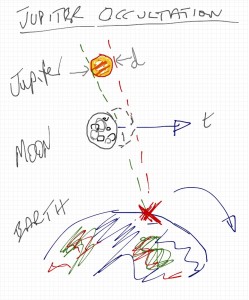[youtube http://www.youtube.com/watch?v=3GS_tMxYXpw&w=560&h=315]
A couple of times a year, the Moon travels across in front of the planet Jupiter. This occurs as the plane of the solar system is roughly in line with the orbit of our moon, but each planet and the moon has its own little wobble or slight inclination to the plane and every now and then there is a noteworthy conjunction. Eclipses, occultation and appulses are all interesting events to astronomers as they can measure timings of these events and calculate speed, distance & diameters of various bodies.
Some terminology:
- Eclipse: when a body moves through a shadow of another body
- Occultation: when a body is obscured by another body moving in front of it
- Appulse: where a minor body moves in front of a background star
An occultation is a fun event and you don’t necessarily need any expensive equipment, even naked eye measurements can give students useful data to run through some calculations. If you do have some camera gear available, its very easy to take some photos on a tripod and use the camera’s clock for the timings which are stored in the image information. In my days as a teenage astronomer I used to play the BBC time service on my shortwave radio and record it on a cassette tape whist I called out the events transitions – Ooops……Now I’m scaring you!
 Last night’s Occultation of Jupiter (visible form Southern Australia) by our Moon was a hoot.
Last night’s Occultation of Jupiter (visible form Southern Australia) by our Moon was a hoot.
Its actually quite deceptive, as due to the rotation of the earth, the moon moves across the sky fairly quickly, but takes some time to catch up with Jupiter, moving about 12 degrees per 24 hours against the back ground stars – half a degree per hour.
Jupiter for the purpose of this exercise is practically stationary, but you can see Jupiter’s own moons move over the course of an hour, yet our moon seems to chase it across the sky.
Last night’s occultation resulted in a first touch at 22:56:17 Local (11:56 UT) and the ingress was complete at 23:07:48 (12:07 UT).
In spite of a few dramas with flat camera batteries needing quick a re-charge and the Moon disappearing behind trees, it was a good result all round. ENJOY!
Lessons Learned: 😉
- Always charge up your camera batteries before you start
- Put your Telescope in a place where the Moon won’t disappear behind a tree
- Make sure your neighbor’s dog gets used to the sound of your telescope slewing
- On a warm night try not to drip sweat on the telescope mirror whilst aligning the scope
Occultations are a great astronomy project for students, as it helps young people visualize the solar system and give them a purpose and practical application for all that “honky” math. Engaging students with exciting applications of mathematical principles can assist them connect with the concepts and encourage them to explore other formula and techniques.
Teaching Resources:
There is some great classroom material on Stellar Occultations at the NASA Wavelength Resources site developed by Montana University.





 Join the Crew!
Join the Crew!
 Escape Velocity Space News
Escape Velocity Space News
0 Comments